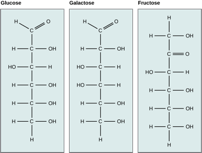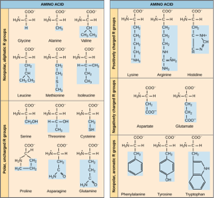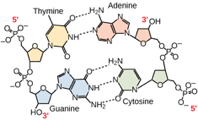Openstax Biology 2e CH 3 book questions - Biological Macromolecules (copy)
0.0(0)
0.0(0)
New
Card Sorting
1/33
Earn XP
Description and Tags
Study Analytics
Name | Mastery | Learn | Test | Matching | Spaced |
|---|
No study sessions yet.
34 Terms
1
New cards
What kind of sugars are these, aldose or ketose?
Glucose and galactose are aldoses. Fructose is a ketose.

2
New cards
Which categories of amino acid would you expect to find on a soluble protein's surface, and which would you expect to find in the interior? What distribution of amino acids would you expect to find in a protein embedded in a lipid bilayer?
Polar and charged amino acid residues (the remainder after peptide bond formation) are more likely to be found on the surface of soluble proteins where they can interact with water, and nonpolar (e.g., amino acid side chains) are more likely to be found in the interior where they are sequestered from water. In membrane proteins, nonpolar and hydrophobic amino acid side chains associate with the hydrophobic tails of phospholipids, while polar and charged amino acid side chains interact with the polar head groups or with the aqueous solution. However, there are exceptions. Sometimes, positively and negatively charged amino acid side chains interact with one another in the interior of a protein, and polar or charged amino acid side chains that interact with a ligand can be found in the ligand binding pocket.

3
New cards
A mutation occurs, and adenine replaces cytosine. What impact do you think this will have on the DNA structure?
Adenine is larger than cytosine and will not be able to base pair properly with the guanine on the opposing strand. This will cause the DNA to bulge. DNA repair enzymes may recognize the bulge and replace the incorrect nucleotide.

4
New cards
Dehydration synthesis leads to formation of
water and polymers
5
New cards
During the breakdown of polymers, which of the following reactions takes place?
hydrolysis
6
New cards
The following chemical reactants produce the ester ethyl ethanoate (C4H8O2):
C2H6O + CH3COOH
What type of reaction occurs to make ethyl ethanoate?
C2H6O + CH3COOH
What type of reaction occurs to make ethyl ethanoate?
condensation
7
New cards
An example of a monosaccharide is ________.
all of the above (fructose, glucose, galactose)
8
New cards
Cellulose and starch are examples of:
polysaccharides
9
New cards
Plant cell walls contain which of the following in abundance?
cellulose
10
New cards
Lactose is a disaccharide formed by the formation of a ________ bond between glucose and ________.
glycosidic; galactose
11
New cards
Which of the following is not an extracellular matrix role of carbohydrates?
provide energy for muscle movement
12
New cards
Saturated fats have all of the following characteristics except:
they tend to dissolve in water easily
13
New cards
Phospholipids are important components of ________.
the plasma membrane of animal cells
14
New cards
Cholesterol is an integral part of plasma membranes. Based on its structure, where is it found in the membrane?
within the tail bilayer
15
New cards
The monomers that make up proteins are called ________.
amino acids
16
New cards
The α-helix and the β-pleated sheet are part of which protein structure?
secondary
17
New cards
Mad cow disease is an infectious disease where one misfolded protein causes all other copies of the protein to begin misfolding. This is an example of a disease impacting ____ structure.
tertiary
18
New cards
A nucleotide of DNA may contain ________.
deoxyribose, thymine, and a phosphate group
19
New cards
The building blocks of nucleic acids are ________.
nucleotides
20
New cards
How does the double helix structure of DNA support its role in encoding the genome?
Complementary base pairing creates a very stable structure.
21
New cards
Why are biological macromolecules considered organic?
Biological macromolecules are organic because they contain carbon.
22
New cards
What role do electrons play in dehydration synthesis and hydrolysis?
In a dehydration synthesis reaction, the hydrogen of one monomer combines with the hydroxyl group of another monomer, releasing a molecule of water. This creates an opening in the outer shells of atoms in the monomers, which can share electrons and form covalent bonds.
23
New cards
Amino acids have the generic structure seen below, where R represents different carbon-based side chains. Describe how the structure of amino acids allows them to be linked into long peptide chains to form proteins
Amino acids can be linked into long chains through condensation reactions. One of the hydrogen atoms bonded to the nitrogen atom of an amino acid reacts with the -OH group attached to the terminal carbon on another amino acid. Since both ends of the molecule can participate in condensation reactions, peptide bonds can be made in both directions to create a long amino acid chain.
24
New cards
Describe the similarities and differences between glycogen and starch.
Glycogen and starch are polysaccharides. They are the storage form of glucose. Glycogen is stored in animals in the liver and in muscle cells, whereas starch is stored in the roots, seeds, and leaves of plants. Starch has two different forms, one unbranched (amylose) and one branched (amylopectin), whereas glycogen is a single type of a highly branched molecule.
25
New cards
Why is it impossible for humans to digest food that contains cellulose?
The β 1-4 glycosidic linkage in cellulose cannot be broken down by human digestive enzymes. Herbivores such as cows, buffalos, and horses are able to digest grass that is rich in cellulose and use it as a food source because bacteria and protists in their digestive systems, especially in the rumen, secrete the enzyme cellulase. Cellulases can break down cellulose into glucose monomers that can be used as an energy source by the animal.
26
New cards
Explain at least three functions that lipids serve in plants and/or animals.
Fat serves as a valuable way for animals to store energy. It can also provide insulation. Waxes can protect plant leaves and mammalian fur from getting wet. Phospholipids and steroids are important components of animal cell membranes, as well as plant, fungal, and bacterial membranes.
27
New cards
Why have trans fats been banned from some restaurants? How are they created?
Trans fats are created artificially when hydrogen gas is bubbled through oils to solidify them. The double bonds of the cis conformation in the hydrocarbon chain may be converted to double bonds in the transconfiguration. Some restaurants are banning trans fats because they cause higher levels of LDL, or "bad" cholesterol.
28
New cards
Why are fatty acids better than glycogen for storing large amounts of chemical energy?
Fats have a higher energy density than carbohydrates (averaging 9kcal/gram versus 4.3kcal/gram respectively). Thus, on a per gram basis, more energy can be stored in fats than can be stored in carbohydrates. Additionally, fats are packaged into spherical globules to minimize interactions with the water-based plasma membrane, while glycogen is a large branched carbohydrate that cannot be compacted for storage.
29
New cards
Part of cortisol's role in the body involves passing through the plasma membrane to initiate signaling inside a cell. Describe how the structures of cortisol and the plasma membrane allow this to occur.
Cortisol is a small, generally hydrophobic molecule, while the phospholipids that create plasma membranes have a hydrophilic head and hydrophobic tails. Since cortisol is hydrophobic, it can interact with the sequestered tails of the phospholipids in the center of the plasma membrane. This, along with its small size, allows cortisol to move through the plasma membrane to the inside of the cell.
30
New cards
Explain what happens if even one amino acid is substituted for another in a polypeptide chain. Provide a specific example.
A change in gene sequence can lead to a different amino acid being added to a polypeptide chain instead of the normal one. This causes a change in protein structure and function. For example, in sickle cell anemia, the hemoglobin β chain has a single amino acid substitution—the amino acid glutamic acid in position six is substituted by valine. Because of this change, hemoglobin molecules form aggregates, and the disc-shaped red blood cells assume a crescent shape, which results in serious health problems.
31
New cards
Describe the differences in the four protein structures.
The sequence and number of amino acids in a polypeptide chain is its primary structure. The local folding of the polypeptide in some regions is the secondary structure of the protein. The three-dimensional structure of a polypeptide is known as its tertiary structure, created in part by chemical interactions such as hydrogen bonds between polar side chains, van der Waals interactions, disulfide linkages, and hydrophobic interactions. Some proteins are formed from multiple polypeptides, also known as subunits, and the interaction of these subunits forms the quaternary structure.
32
New cards
Aquaporins are proteins embedded in the plasma membrane that allow water molecules to move between the extracellular matrix and the intracellular space. Based on its function and location, describe the key features of the protein's shape and the chemical characteristics of its amino acids.
The protein must form a channel in the plasma membrane that allows water into the cell since water cannot cross the plasma membrane by itself. Since aquaporins are embedded in the plasma membrane and connect with both the intracellular and extracellular spaces, it must be amphipathic like the plasma membrane. The top and bottom of the protein must contain charged or polar amino acids (hydrophilic) to interact with the aqueous environments. The exterior transmembrane region must contain non-polar amino acids (hydrophobic) that can interact with the phospholipid tails. However, the inside of this channel must contain hydrophilic amino acids since they will interact with the traveling water molecules.
33
New cards
What are the structural differences between RNA and DNA?
DNA has a double-helix structure. The sugar and the phosphate are on the outside of the helix and the nitrogenous bases are in the interior. The monomers of DNA are nucleotides containing deoxyribose, one of the four nitrogenous bases (A, T, G and C), and a phosphate group. RNA is usually single-stranded and is made of ribonucleotides that are linked by phosphodiester linkages. A ribonucleotide contains ribose (the pentose sugar), one of the four nitrogenous bases (A, U, G, and C), and the phosphate group.
34
New cards
What are the four types of RNA and how do they function?
The four types of RNA are messenger RNA, ribosomal RNA, transfer RNA, and microRNA. Messenger RNA carries the information from the DNA that controls all cellular activities. The mRNA binds to the ribosomes that are constructed of proteins and rRNA, and tRNA transfers the correct amino acid to the site of protein synthesis. microRNA regulates the availability of mRNA for translation.